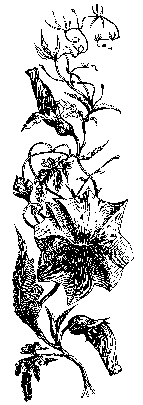


The apple is an ever-present staple item in our produce basket. They offer variety in flavor, texture, and aroma. Apples can also be tasty and soothing medicine if our bodies get tired out or injured. They can help flush the system clean and may even inhibit the growth of certain microorganisms.
Researchers from the Bureau of Microbial Hazards in Ottawa discovered that fresh apple juice showed strong antiviral activity on viruses such as polio. These components are found in the pulp and skin; apple cider and wine showed a lesser degree of activity, while long storage of the juice and exposure to heat greatly reduced this activity. Fresh grapes and fresh grape juice also show antiviral activity.
Archaeologists have found the remains of apples in Stone Age villages in Switzerland and Austria. The apple was cultivated along the Nile River as early as 1200 bce. A temperate fruit originating in Eurasia, over two thousand known and cultivated varieties of apples descend from the wild crab apple. The first apple trees in North America arrived in the early seventeenth century. If you’ve ever noticed the resemblance in form or flavor between rosehips and apples, it’s because apples are a member of the Rose family.
Eating raw apples stimulates the gums, and eating an apple at bedtime is said to give sweet breath in the morning. Apples stimulate the liver, colon, spleen, and kidneys; the pectin helps aid digestion. Soft apples can be eaten for a laxative effect—as anyone with black bears in their orchard will attest to—while a one- or two-day fast (exclusive diet) of less-than-ripe apples will remedy diarrhea. Apples are the perfect snack for kids of all ages, as the natural fruit sugar passes into the bloodstream for quick energy without a sugar rush.
Apple pulp can be used as a poultice on inflammations and swellings such as nettle’s rash, hives, or insect bites and stings. To make an apple pulp, simply grate enough freshly washed apple against a box grater until you have enough to cover the site, about one tablespoon for a sting, and place this pulp directly on the site for about fifteen minutes; this is a simple poultice. As an even quicker remedy on the hiking trail, just take a bite of apple, chew it up a little, and plaster this to the sting or scrape or whatever. Large areas such as for sunburn would be better remedied by using a so-called plaster: spread the grated apple pulp (in this case one or two cups) between two layers of gauze or cheesecloth (cut to size for the area to be treated), and carefully lay this cloth over the shoulders or back or wherever the sunburn is located; leave on for about fifteen minutes or until it starts to feel better.
When diluted with water by half, apple cider vinegar is a good wash for sunburn (of course, an ounce of prevention …). To soothe and soften the skin, you can apply this half-and-half dilution with a washcloth to the face and neck, or lay across the forehead to reduce fatigue. Undiluted apple cider vinegar also makes a good compress for gout; just pour some onto a soft cloth and wrap around the affected area, rewetting it every ten minutes or so until the pain subsides. See the section “V is for Vinegar” on page 277 for more ways to use apple cider vinegar for food as well as home remedies.
One way to enjoy apples along with other seasonal harvests is to make this revved-up relish to serve with roast pork or spicy lamb curry. I have experimented with different scented mints for this recipe, including apple mint (which I didn’t care for in this dish) and peppermint (which was too strong), and found that a stem or two of pineapple mint is a good addition to the spearmint, which to me tastes best here, sweet and refreshing. Check out “M is for Mint” on page 208 for more about this fragrant family.

Apple Mint Relish
2 cups spearmint leaves (do not use the coarse stems), chopped fine
1 large tart apple, cored, peeled, and chopped fine
½ cup finely chopped sweet onion
1 or 2 jalapeño peppers, seeded and minced
¼ cup lemon juice
¼ cup olive oil
Pinch of sugar
Salt and pepper
Combine mint, apple, onion, and jalapeños in a bowl. In a separate bowl, mix the lemon juice, olive oil, sugar, and seasonings, then pour over apple mixture and toss. Serve at room temperature.
Apple blossoms have been used to make a fragrant wine, and an infusion (medicinal tea) of the blossoms has been used for sore throats and colds. I suggest taking the blossoms from a very overgrown tree; otherwise, you will end up picking off potential fruit. I have found several online sites with recipes for floral wines, and Steven A. Krause has explored this and other interesting concoctions in Wine from the Wilds.
In The Herb Book, John Lust says that the dried peels of apples were used as a tea for “rheumatic illness.” Mrs. M. Grieve, in A Modern Herbal, says that a mild apple beverage is drunk cool for feverish conditions.

Apple Water
Take 3 to 4 whole unpeeled apples, slice thin, place in a large saucepan with 2 quarts of water, and bring to a boil; reduce heat, then simmer until soft, about 20 minutes. Strain, stir in 2 tablespoons honey, then cool to serve. Drink throughout the day as needed. This brew keeps for 2 days refrigerated, but you will likely drink all of it the first day.
Apple cider was an important staple in the colonial American kitchen. Families and villages would keep barrels upon barrels of it during the cooler fall and winter months of the year. Good cider is made from a combination of several apple types; hard cider has been fermented from this luscious nectar. From there, the savvy colonial housewife would make apple cider vinegar. Most of the apples grown in America today are created by grafting scion (a branch cutting) onto specific rootstock; rarely are apples started from seed on purpose. An apple called a pippin, however, such as Cox’s Orange Pippin, most likely originates from a seed, or pip. If it hadn’t been for the visionary John Chapman—fondly remembered by the name of Johnny Appleseed—the hundreds of orchards in Pennsylvania and Ohio would have matured decades later (it takes about twenty years for a standard apple tree to reach full maturity; the young trees we buy at a nursery are already four to seven years old!). Chapman procured his seed from the village cider press, which was not uncommon for the day. Around 1800, he literally led the way across the so-called Western frontier, clearing brush, planting apple seeds, then getting someone to tend the infant orchard in his stead. Then on he’d go, in his simple garb and long hair, an itinerant wanderer with humble personal needs. His obsession with starting apple trees from seed is not only legend: he is considered the patron saint of orchards.
The curious custom of Wassail—from the Anglo-Saxon wes hal, meaning “be whole” or to drink “to the health” of—is a midwinter toast to the apple orchard, and possibly dates back to the fifth century; some believe it is a relic held over from Roman sacrifices to Pomona, goddess of fruit. It was certainly practiced in the West Country of England up until very recently, and many neopagans and period-revivalists still do so—and why not? The tradition took place on Twelfth Night, usually around January 5. A biscuit or cake doused with cider was laid on a tree branch, doused again, and then all the folks who had gathered in the orchard would sing carols or hymns—“Hats full! Caps full! Bushel-bushel-sacks full!”—and bang pots and pans together, with the men sometimes shooting their guns into the air, generally making a great noise to ward off uninvited bad spirits and to let the beneficent spirits know where the apple trees were. The wassail bowl was sometimes passed around and shared as a “loving cup” or was brought door to door to wassail the neighbors and their homes. Sometimes even beehives were wassailed. Proclaiming a toast to those things in life that are vital and necessary, such as food and friends, makes a lot of sense, and we can see that wassail is an activity as well as a food item. Some recipes for wassail feature baked apples floating around the punch bowl. Most wassail recipes include brandy, stout, or some kind of alcohol, although you could certainly make it without. There are several recipes to be found online.
An apple decoratively studded with cloves was the original pomander, which makes sense since the apple is a pome-type fruit. In his book Magical Aromatherapy, Scott Cunningham reminds us that “any and all ‘apple blossom essential oils’ you may see in stores are synthetic [because] no true essential oil is available.” He suggests that come spring you find yourself an actual apple tree in bloom and inhale the fragrance, “breathing in peace, contentment, and freedom from worry.” Visualize all negative thoughts coalescing as you breathe in the fragrance, and as you exhale, dispel them to the four winds to be transformed (just do it—your neighbors already wonder about you anyway).
Indeed, the very sight of apple blossoms gives one a feeling of exuberance and joy, and a tree of ripened apples gives us pause to appreciate the turning of the seasons, realizing that “the love we share has ripened like an orchard full of apples,” or so goes a not-so-old song. It’s no wonder that apples were once hung on the Yule tree for winter solstice celebrations, a symbol not only of the continuity of life, death, and rebirth but also of the awesome fertile planet Earth, our mother home. It would do us well to contemplate the apple more often.